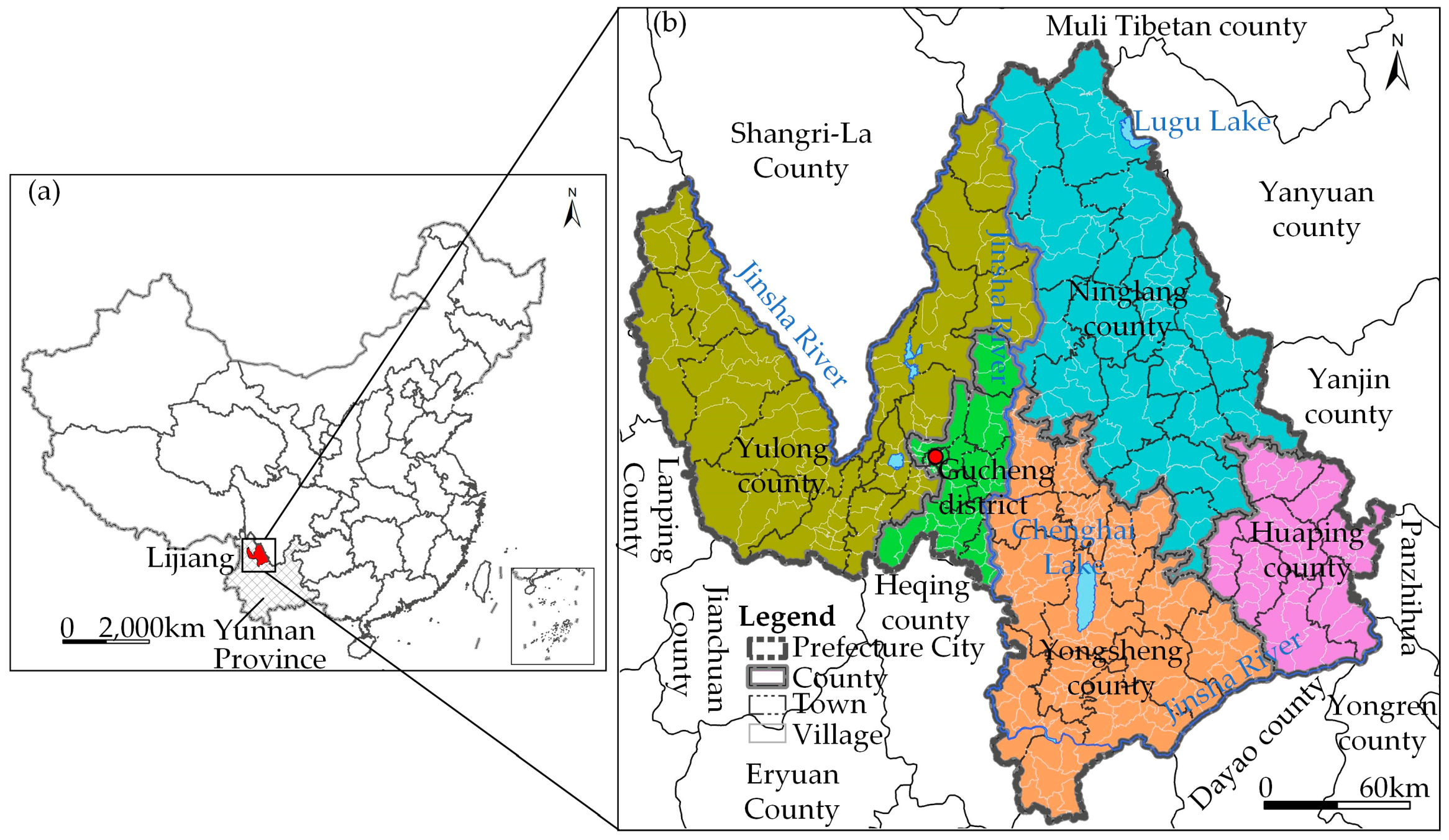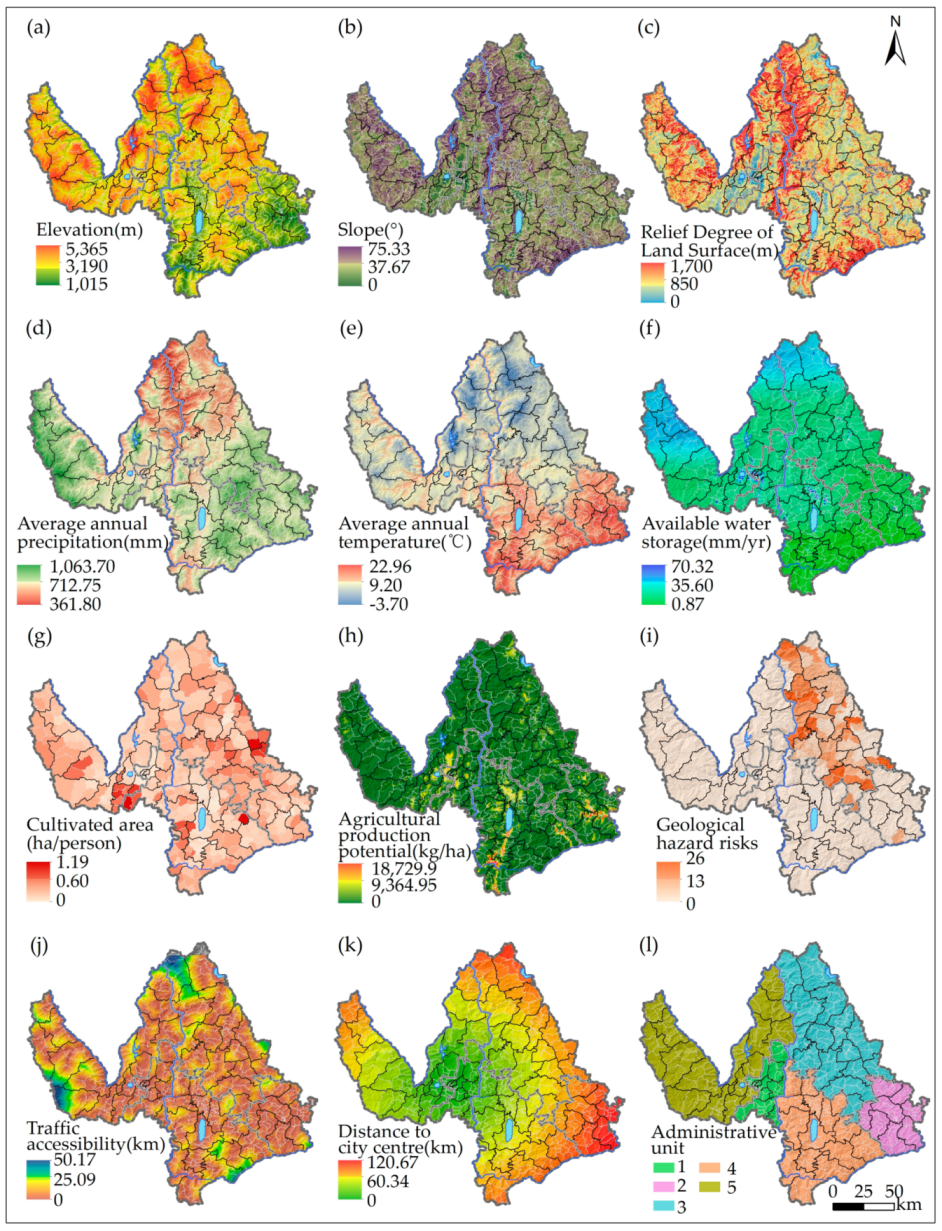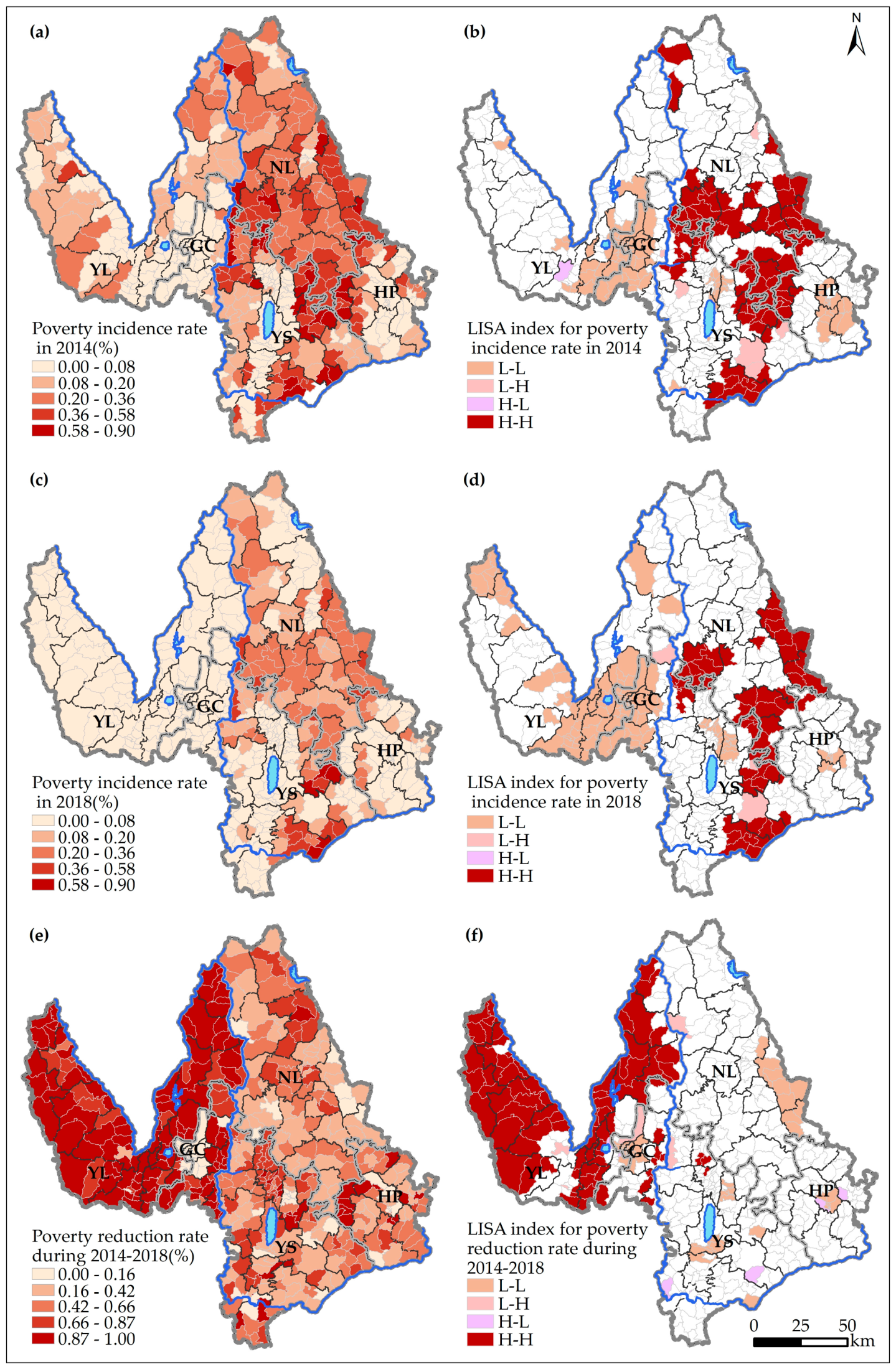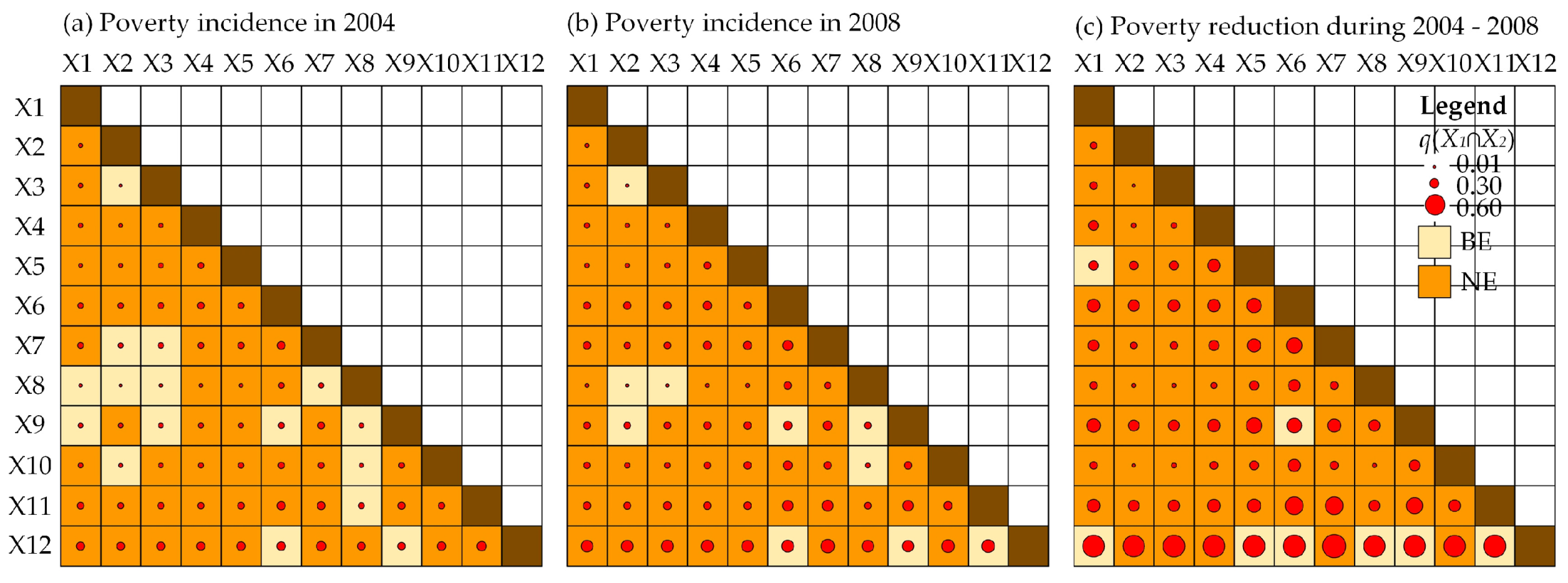The Nexus between Poverty and the Environment: A Case Study of Lijiang, China
Abstract
:1. Introduction
2. Methodology
2.1. Study Area
2.2. Methods and Data Resources
2.2.1. Poverty Incidence and Poverty Reduction Rates
2.2.2. Spatial Analysis and Spatial Autocorrelation
2.2.3. Potential Environmental Factors of Poverty Incidence and Reduction
2.2.4. GeoDetector
3. Results
3.1. Spatial Patterns
3.1.1. Overview of Spatial Distribution
3.1.2. Changes in Spatial Pattern of Poverty Incidence During 2014–2018
3.1.3. Spatial Pattern of Poverty Reduction During 2014–2018
3.2. Effects of Environmental Factors
3.2.1. Main Environmental Factors of Poverty Incidence
3.2.2. Main Environmental Factors of Poverty Reduction
3.2.3. Multivariate Interaction
4. Discussion
4.1. Environmental Effects on Poverty Incidence and Reduction
4.2. Roles of Socioeconomic Factors
4.3. Policy Implications
5. Conclusions
Author Contributions
Funding
Acknowledgments
Conflicts of Interest
References
- Zhang, J.; Zuo, F.; Zhou, Y.; Zhai, M.; Mei, L.; Fu, Y.; Cheng, Y. Analyzing Influencing Factors of Rural Poverty in Typical Poverty Areas of Hainan Province: A Case Study of Lingao County. Chin. Geogr. Sci. 2018, 28, 1061–1076. [Google Scholar] [CrossRef] [Green Version]
- Haushofer, J.; Fehr, E. On the psychology of poverty. Science 2014, 344, 862–867. [Google Scholar] [CrossRef] [PubMed]
- Liu, Y.; Liu, J.; Zhou, Y. Spatio-temporal patterns of rural poverty in China and targeted poverty alleviation strategies. J. Rural Stud. 2017, 52, 66–75. [Google Scholar] [CrossRef]
- Griggs, D.; Stafford-Smith, M.; Gaffney, O.; Rockström, J.; Öhman, M.C.; Shyamsundar, P.; Noble, I. Policy: Sustainable development goals for people and planet. Nature 2013, 495, 305–307. [Google Scholar] [CrossRef] [PubMed]
- Eshelman, R.S. Revolt of the Gadgets. Baffler 2012, 19, 101–106. [Google Scholar] [CrossRef]
- Chen, M.; Sui, Y.; Liu, W.; Liu, H.; Huang, Y. Urbanization patterns and poverty reduction: A new perspective to explore the countries along the Belt and Road. Habitat Int. 2019, 84, 1–14. [Google Scholar] [CrossRef]
- Sachs, J.D. The End of Poverty; Penguin Press: London, UK, 2005. [Google Scholar]
- Reardon, T.; Lansing, E.; Vosti, S.A.; Food, I. Links Between Rural Poverty and the Environment in Developing Countries: Asset Categories and Investment Poverty. World Dev. 1995, 23, 1495–1506. [Google Scholar] [CrossRef]
- UNDPC. China, the Millenium Development Goals, and the Post-2015 Development Agenda; UNDPC: Beijing, China, 2015. [Google Scholar]
- World Bank. World Development Report 2015: Mind, Society, and Behavior; World Bank: Washington, DC, USA, 2015. [Google Scholar]
- Guo, Y.; Zhou, Y.; Cao, Z. Geographical patterns and anti-poverty targeting post-2020 in China. J. Geogr. Sci. 2018, 28, 1810–1824. [Google Scholar]
- Wang, L.; Chen, L. Analysis: The impact of new transportation modes on population distribution in Jing-Jin-Ji region of China. Sci. Data 2018, 5, 1–15. [Google Scholar] [CrossRef] [Green Version]
- Fransman, T.; Yu, D. Multidimensional poverty in South Africa in 2001–16. Dev. S. Afr. 2018, 36, 1–31. [Google Scholar] [CrossRef] [Green Version]
- Alkire, S.; Foster, J. Counting and multidimensional poverty measurement. J. Public Econ. 2011, 95, 476–487. [Google Scholar] [CrossRef]
- Wen, Q.; Shi, L.; Ma, C.; Wang, Y. Spatial heterogeneity of multidimensional poverty at the village level: Loess Plateau. Acta Geogr. Sin. 2018, 73, 1850–1864. [Google Scholar]
- Ren, Q.; Huang, Q.; He, C.; Tu, M. The poverty dynamics in rural China during 2000–2014: A multi-scale analysis based on the poverty gap index. J. Geogr. Sci. 2018, 28, 1427–1443. [Google Scholar] [CrossRef] [Green Version]
- Nasution, D.H.; Bangun, P.; Sitepu, H.R. Factors that Affect Poverty Areas in North Sumatera Using Discriminant Analysis. IOP Conf. Ser. Mater. Sci. Eng. 2018, 335, 012043. [Google Scholar] [CrossRef]
- Liu, Y.; Li, Y. Revitalize the world’s countryside. Nature 2017, 548, 275–277. [Google Scholar] [CrossRef] [PubMed]
- Magombeyi, M.T.; Odhiambo, N.M. Poverty dynamics in Botswana: Policies, trends and challenges. Cogent Soc. Sci. 2017, 3, 1–12. [Google Scholar] [CrossRef]
- UN (United Nations). Poverty [EB/OL]. Available online: https://wayback.archive-it.org/10611/20160908121214/http://www.unesco.org/new/en/social-and-human-sciences/themes/international-migration/glossary/poverty/ (accessed on 20 May 2019).
- Ferreira FH, G.; Chen, S.; Dabalen, A.; Dikhanov, Y.; Hamadeh, N.; Jolliffe, D.; Yoshida, N. A global count of the extreme poor in 2012: Data issues, methodology and initial results. J. Econ. Inequal. 2016, 14, 141–172. [Google Scholar] [CrossRef] [Green Version]
- UNDP (United Nation Development Programme). Global multidimensional poverty index 2019 [EB/OL]. Available online: https://max.book118.com/html/2019/0715/7112146026002041.shtm (accessed on 20 May 2019).
- Henderson, V. Measuring Economic Growth from Outer Space. Am. Econ. Rev. 2009, 102, 994–1028. [Google Scholar] [CrossRef] [Green Version]
- Llorente, A.; Garcia-herranz, M.; Cebrian, M.; Moro, E. Social Media Fingerprints of Unemployment. PLoS ONE 2015, 10, e0128692. [Google Scholar] [CrossRef] [Green Version]
- Dubm, S. Network Diversity and Economic Development. Science 2010, 328, 1029–1032. [Google Scholar]
- Blumenstock, J.E. Fighting poverty with data. Science 2016, 353, 753–754. [Google Scholar] [CrossRef] [PubMed]
- Zhou, L.; Xiong, L. Concentration or diffusion? Exploring the emerging spatial dynamics of poverty distribution in Southern California. Cities 2018, 90, 282–292. [Google Scholar]
- Pan, J.; Hu, Y. Spatial Identification of Multi-dimensional Poverty in Rural China: A Perspective of Nighttime-Light Remote Sensing Data. J. Indian Soc. Remote Sens. 2018, 46, 1093–1111. [Google Scholar] [CrossRef]
- Curtis, K.J.; Lee, J.; O’Connell, H.A.; Zhu, J. The Spatial Distribution of Poverty and the Long Reach of the Industrial Makeup of Places: New Evidence on Spatial and Temporal Regimes. Rural Sociol. 2018, 84, 28–65. [Google Scholar] [CrossRef] [PubMed] [Green Version]
- Ma, Z.; Chen, X.; Chen, H. Multi-scale Spatial Patterns and Influencing Factors of Rural Poverty: A Case Study in the Liupan Mountain Region, Gansu Province, China. Chin. Geogr. Sci. 2018, 28, 296–312. [Google Scholar] [CrossRef] [Green Version]
- Cali, M.; Menon, C. Does urbanization affect rural poverty? Evidence from Indian districts. World Bank Econ. Rev. 2013, 27, 171–201. [Google Scholar] [CrossRef] [Green Version]
- Fosu, A.K. The effect of income distribution on the ability of growth to reduce poverty: Evidence from rural and urban African economies. Am. J. Econ. Sociol. 2010, 69, 1034–1053. [Google Scholar] [CrossRef]
- McKernan, S.; Ratcliffe, C. Transitioning in and Out of Poverty. Urban Inst. 2009, 9, 1–2. [Google Scholar]
- Stevens, A.H.; Davis, U.C. Transitions into and out of Poverty in the United States. Policy Brief, Center for Poverty Research [EB/OL]. Available online: https://poverty.ucdavis.edu/policy-brief/transitions-out-poverty-united-states (accessed on 12 June 2019).
- Gray, L.C.; Moseley, W.G. A Geographical Perspective on Poverty-Environment Interactions. Geogr. J. 2012, 171, 9–23. [Google Scholar] [CrossRef]
- Scott, L. Chronic Poverty and the Environment: A Vulnerability Perspective. SSRN Electron. J. 2006, 8, 1–26. [Google Scholar] [CrossRef]
- Schleicher, J.; Schaafsma, M.; Burgess, N.D.; Sandbrook, C.; Danks, F.; Cowie, C.; Vira, B. Poorer without It? The Neglected Role of the Natural Environment in Poverty and Wellbeing. Sustain. Dev. 2018, 26, 83–98. [Google Scholar] [CrossRef] [Green Version]
- Lv, L.; Sun, F.; Huang, R. Innovation-based urbanization: Evidence from 270 cities at the prefecture level or above in China. Acta Geogr. Sin. 2018, 73, 1910–1922. [Google Scholar]
- RESDC (Resources and Environmental Sciences Data Center). China’s agricultural production potential data sets [EB/OL]. Available online: http://www.resdc.cn/DOI (accessed on 20 March 2019).
- Wang, J.; Xu, C. Geodetector: Principle and prospective. Acta Geogr. Sin. 2017, 72, 116–134. [Google Scholar]
- Liu, Y.; Li, J. Geographic detection and optimizing decision of the differentiation mechanism of rural poverty in China. Acta Geogr. Sin. 2017, 72, 161–173. [Google Scholar]
- Scott, S.; Conacher, A. Land Degradation and Poverty. Nat. Sustain. 2008, 46, 1–3. [Google Scholar] [CrossRef]
- Guo, J.; Zhang, B.; Zhang, X. Study on Rural Poverty Reduction Effect of Traffic Infrastructure. Asian Agric. Res. 2014, 6, 4–8. [Google Scholar]




| Categories | Environmental Factors | Unit | Resolution | Data Resources and Processing |
|---|---|---|---|---|
| Topography | X1: Elevation | m | 90 m | Download from the Resources and Environmental Sciences Data Center (RESDC) |
| X2: Slope | ° | 90 m | Calculated by Slope Tool in Spatial Analysis Tools based on elevation data | |
| X3: Relief degree of land surface (RDLS) | m | 90 m | Calculated by Focal Statistics Tool in Spatial Analysis Tools based on elevation data | |
| Climate | X4: Average annual precipitation | mm | 1 km | Download from the RESDC |
| X5: Average annual temperature | °C | 1 km | Download from the RESDC | |
| Water resources | X6: Available water storage | mm/yr | 1 km | Using Gravity Recovery and Climate Experiment (GRACE) satellite data (level 2, release 05) from three institutes: the Center for Space Research (CSR), the Geo Forschungs Zentrum (GFZ), and the Jet Propulsion Laboratory (JPL) |
| Land resources | X7: Per capita cultivated area | ha/person | 1 km | Obtained from Lijiang Municipal Government |
| X8: Agricultural production potential | kg/ha | 1 km | Download from the RESDC | |
| Natural risks | X9: Geological hazard risks | / | 1 km | Obtained from Lijiang Municipal Government |
| Traffic | X10: Traffic accessibility | km | 1 km | Calculated by Cost Distance Tool in Spatial Analysis Tools based on various traffic data |
| Location | X11: Distance to city center | km | 1 km | Calculated by Distance Tool in Spatial Analysis Tools |
| Policy | X12: Administrative unit | / | 1 km | Dummy variable takes the value of 1 for Gucheng District, 2 for Yulong County, 3 for Huaping County, 4 for Ninglang County, and 5 for Yongsheng County |
| Area Name | ||||||
|---|---|---|---|---|---|---|
| Gucheng District | 1880 | 1.23% | 137 | 0.09% | 1743 | 92.71% |
| Yulong County | 15,678 | 7.13% | 1168 | 0.52% | 14,510 | 92.55% |
| Yongsheng County | 61,548 | 15.26% | 29,218 | 7.19% | 32,330 | 52.53% |
| Huaping County | 17,137 | 10.67% | 6197 | 3.83% | 10,940 | 63.84% |
| Ninglang County | 79,341 | 28.82% | 46,862 | 16.79% | 32,479 | 40.94% |
| Lijiang Prefecture | 175,584 | 14.49% | 83,582 | 6.81% | 92,002 | 52.40% |
| Factors | |||||||||
|---|---|---|---|---|---|---|---|---|---|
| q | p | rank | q | p | rank | q | p | rank | |
| Elevation | 0.030 | 0 | 9 | 0.012 | 0 | 11 | 0.038 | 0 | 6 |
| Slope | 0.027 | 0 | 12 | 0.015 | 0 | 10 | 0.002 | 0 | 11 |
| Relief degree of land surface | 0.037 | 0 | 8 | 0.020 | 0 | 8 | 0.005 | 0 | 10 |
| Average annual precipitation | 0.027 | 0 | 11 | 0.016 | 0 | 9 | 0.021 | 0 | 8 |
| Average annual temperature | 0.028 | 0 | 10 | 0.006 | 0 | 12 | 0.060 | 0 | 5 |
| Available water storage | 0.113 | 0 | 3 | 0.121 | 0 | 2 | 0.115 | 0 | 2 |
| Per capita cultivated area | 0.111 | 0 | 4 | 0.092 | 0 | 5 | 0.037 | 0 | 7 |
| Agricultural production potential | 0.039 | 0 | 7 | 0.022 | 0 | 7 | 0.014 | 0 | 9 |
| Geological hazard risk | 0.083 | 0 | 5 | 0.108 | 0 | 3 | 0.114 | 0 | 3 |
| Traffic accessibility | 0.063 | 0 | 6 | 0.045 | 0 | 6 | 0.002 | 0.015 | 12 |
| Distance to city center | 0.129 | 0 | 2 | 0.099 | 0 | 4 | 0.108 | 0 | 4 |
| Administrative unit | 0.251 | 0 | 1 | 0.331 | 0 | 1 | 0.466 | 0 | 1 |
© 2020 by the authors. Licensee MDPI, Basel, Switzerland. This article is an open access article distributed under the terms and conditions of the Creative Commons Attribution (CC BY) license (http://creativecommons.org/licenses/by/4.0/).
Share and Cite
Gao, P.; Liu, S.; Qi, W.; Qi, H. The Nexus between Poverty and the Environment: A Case Study of Lijiang, China. Sustainability 2020, 12, 1066. https://doi.org/10.3390/su12031066
Gao P, Liu S, Qi W, Qi H. The Nexus between Poverty and the Environment: A Case Study of Lijiang, China. Sustainability. 2020; 12(3):1066. https://doi.org/10.3390/su12031066
Chicago/Turabian StyleGao, Ping, Shenghe Liu, Wei Qi, and Honggang Qi. 2020. "The Nexus between Poverty and the Environment: A Case Study of Lijiang, China" Sustainability 12, no. 3: 1066. https://doi.org/10.3390/su12031066
APA StyleGao, P., Liu, S., Qi, W., & Qi, H. (2020). The Nexus between Poverty and the Environment: A Case Study of Lijiang, China. Sustainability, 12(3), 1066. https://doi.org/10.3390/su12031066





